Phytochemical and Flavor Characteristics of Mulberry Juice Fermented with Lactiplantibacillus plantarum BXM2
Abstract
:1. Introduction
2. Materials and Methods
2.1. Materials and Reagents
2.2. Fermentation of Mulberry Juice with BXM2
2.3. Analysis of Organoleptic Characteristics
2.4. Analysis of Non-Volatile Metabolites
2.5. Analysis of Volatile Metabolites
2.6. Statistical Analysis
3. Results and Discussion
3.1. Growth of L. plantarum BXM2 and pH Changes during Fermentation
3.2. Evaluation of Organoleptic Characteristics
3.3. Changes of Non-Volatile Metabolites
3.3.1. Metabolite Composition and OPLS-DA Analysis
3.3.2. Statistics of Differential Non-Volatile Metabolites
3.3.3. Changes of Non-Volatile Metabolites after L. plantarum BXM2 Fermentation
3.4. Changes of Volatile Compounds
3.4.1. Statistical Analysis of Volatile Compounds
3.4.2. Analysis of ROAV of Differential Volatiles
4. Conclusions
Supplementary Materials
Author Contributions
Funding
Institutional Review Board Statement
Informed Consent Statement
Data Availability Statement
Conflicts of Interest
References
- Jia, Z.; Tang, M.; Wu, J. The determination of flavanoid contents on mulberry and their scavenging effects on superoxide radical. Food Chem. 1999, 64, 555–559. [Google Scholar]
- Yuan, Q.; Zhao, L. The Mulberry (Morus alba L.) Fruit-A Review of Characteristic Components and Health Benefits. J. Agric. Food Chem. 2017, 65, 10383–10394. [Google Scholar] [CrossRef] [PubMed]
- Zhang, H.; Ma, Z.F.; Luo, X.; Li, X. Effects of Mulberry Fruit (Morus alba L.) Consumption on Health Outcomes: A Mini-Review. Antioxidants 2018, 7, 69. [Google Scholar] [CrossRef] [PubMed]
- Ma, Y.; Chen, X.; Xu, R.; Niu, H.; Huang, Q.; Zhou, Y. Lactiplantibacillus plantarum fermentation enhanced the protective effect of kiwifruit on intestinal injury in rats: Based on mitochondrial morphology and function. Food Chem. X 2023, 20, 101025. [Google Scholar] [CrossRef] [PubMed]
- Septembre-Malaterre, A.; Remize, F.; Poucheret, P. Fruits and vegetables, as a source of nutritional compounds and phytochemicals: Changes in bioactive compounds during lactic fermentation. Food Res. Int. 2018, 104, 86–99. [Google Scholar] [CrossRef]
- Ricci, A.; Marrella, M.; Hadj Saadoun, J.; Bernini, V.; Godani, F.; Dameno, F.; Neviani, E.; Lazzi, C. Development of Lactic Acid-Fermented Tomato Products. Microorganisms 2020, 8, 1192. [Google Scholar] [CrossRef]
- Laophongphit, A.; Wichiansri, S.; Siripornadulsil, S.; Siripornadulsil, W. Enhancing the nutritional value and functional properties of mango pulp via lactic acid bacteria fermentation. LWT 2024, 197, 115878. [Google Scholar] [CrossRef]
- Jiang, J.; Yin, R.; Xie, Y.; Ma, X.; Cui, M.; Chen, Y.; Li, Y.; Hu, Y.; Niu, J.; Cheng, W.; et al. Effects of cofermentation of Saccharomyces cerevisiae and different lactic acid bacteria on the organic acid content, soluble sugar content, biogenic amines, phenol content, antioxidant activity and aroma of prune wine. Food Chem. X 2024, 22, 101502. [Google Scholar] [CrossRef]
- Kwaw, E.; Ma, Y.; Tchabo, W.; Apaliya, M.T.; Wu, M.; Sackey, A.S.; Xiao, L.; Tahir, H.E. Effect of lactobacillus strains on phenolic profile, color attributes and antioxidant activities of lactic-acid-fermented mulberry juice. Food Chem. 2018, 250, 148–154. [Google Scholar] [CrossRef]
- Zhang, Q.; Zhao, Q.; Li, T.; Lu, L.; Wang, F.; Zhang, H.; Liu, Z.; Ma, H.; Zhu, Q.; Wang, J.; et al. Lactobacillus plantarum-derived indole-3-lactic acid ameliorates colorectal tumorigenesis via epigenetic regulation of CD8(+) T cell immunity. Cell Metab. 2023, 35, 943–960.e9. [Google Scholar] [CrossRef]
- Lan, T.; Zeng, Q.; Chen, L.; Tu, Z.; Ye, Y.; Liu, Y.; He, W. Comparison of Volatile and Nonvolatile Metabolites in Black Tea under Four Second-Drying Methods Using Widely Targeted Metabolomics. Foods 2023, 13, 144. [Google Scholar] [CrossRef] [PubMed]
- Guan, X.; Zhao, D.; Yang, Y.; Huang, J.; Lin, B.; Zheng, Y.; Wang, Q. Characterization and in vitro assessment of probiotic potential of Lactiplantibacillus plantarum BXM2 from fermented honey passion fruit beverage. Food Front. 2023, 4, 1372–1381. [Google Scholar] [CrossRef]
- Gao, F.; Guan, L.; Zeng, G.; Hao, X.; Li, H.; Wang, H. Preliminary characterization of chemical and sensory attributes for grapes and wines of different cultivars from the Weibei Plateau region in China. Food Chem. X 2024, 21, 101091. [Google Scholar] [CrossRef]
- Chen, W.; Gong, L.; Guo, Z.; Wang, W.; Zhang, H.; Liu, X.; Yu, S.; Xiong, L.; Luo, J. A novel integrated method for large-scale detection, identification, and quantification of widely targeted metabolites: Application in the study of rice metabolomics. Mol. Plant 2013, 6, 1769–1780. [Google Scholar] [CrossRef] [PubMed]
- Eriksson, L.; Trygg, J.; Wold, S. CV-ANOVA for significance testing of PLS and OPLS® models. J. Chemom. 2008, 22, 594–600. [Google Scholar] [CrossRef]
- Galindo-Prieto, B.; Eriksson, L.; Trygg, J. Variable influence on projection (VIP) for orthogonal projections to latent structures (OPLS). J. Chemom. 2014, 28, 623–632. [Google Scholar] [CrossRef]
- Wang, Y.; Yang, C.; Li, S.; Yang, L.; Wang, Y.; Zhao, J.; Jiang, Q. Volatile characteristics of 50 peaches and nectarines evaluated by HP–SPME with GC–MS. Food Chem. 2009, 116, 356–364. [Google Scholar] [CrossRef]
- GB 23200.8-2016; Determination of 500 Pesticides and Related Chemicals Residues in Fruits and Vegetables Gas Chromatography-Mass Spectrometry. National Food Safety Standards: Beijing, China, 2017. (In Chinese)
- 19 Zhu, J.; Niu, Y.; Xiao, Z. Characterization of the key aroma compounds in Laoshan green teas by application of odour activity value (OAV), gas chromatography-mass spectrometry-olfactometry (GC-MS-O) and comprehensive two-dimensional gas chromatography mass spectrometry (GC × GC-qMS). Food Chem. 2021, 339, 128136. [Google Scholar] [CrossRef]
- Yang, Y.; Ai, L.; Mu, Z.; Liu, H.; Yan, X.; Ni, L.; Zhang, H.; Xia, Y. Flavor compounds with high odor activity values (OAV > 1) dominate the aroma of aged Chinese rice wine (Huangjiu) by molecular association. Food Chem. 2022, 383, 132370. [Google Scholar] [CrossRef]
- Bachmanov, A.A.; Bosak, N.P.; Glendinning, J.I.; Inoue, M.; Li, X.; Manita, S.; McCaughey, S.A.; Murata, Y.; Reed, D.R.; Tordoff, M.G.; et al. Genetics of Amino Acid Taste and Appetite. Adv. Nutr. 2016, 7, 806s–822s. [Google Scholar] [CrossRef]
- Bell, L.; Methven, L.; Signore, A.; Oruna-Concha, M.J.; Wagstaff, C. Analysis of seven salad rocket (Eruca sativa) accessions: The relationships between sensory attributes and volatile and non-volatile compounds. Food Chem. 2017, 218, 181–191. [Google Scholar] [CrossRef] [PubMed]
- Jo, S.W.; An, J.H.; Kim, D.S.; Yim, E.J.; Kang, H.J.; Kim, H.J. Comparative Metabolomic Analysis of Moromi Fermented Using Different Aspergillus oryzae Strains. Molecules 2022, 27, 6182. [Google Scholar] [CrossRef] [PubMed]
- Geiselhart, S.; Podzhilkova, A.; Hoffmann-Sommergruber, K. Cow’s Milk Processing-Friend or Foe in Food Allergy? Foods 2021, 10, 572. [Google Scholar] [CrossRef] [PubMed]
- Wang, B.; Yang, Y.; Bian, X.; Guan, H.N.; Liu, L.L.; Li, X.X.; Guo, Q.Q.; Piekoszewski, W.; Chen, F.L.; Wu, N.; et al. Proliferation of Bifidobacterium L80 under different proportions of milk protein hydrolysate. Microb. Cell Fact. 2021, 20, 213. [Google Scholar] [CrossRef] [PubMed]
- Xu, D.; Fang, M.; Wang, H.; Huang, L.; Xu, Q.; Xu, Z. Enhanced production of 5-hydroxytryptophan through the regulation of L-tryptophan biosynthetic pathway. Appl. Microbiol. Biotechnol. 2020, 104, 2481–2488. [Google Scholar] [CrossRef] [PubMed]
- Yang, L.; Gao, Y.; Farag, M.A.; Gong, J.; Su, Q.; Cao, H.; Zhang, W.; Zhao, Y.; Wang, H. Dietary flavonoids and gut microbiota interaction: A focus on animal and human studies to maximize their health benefits. Food Front. 2023, 4, 1794–1809. [Google Scholar] [CrossRef]
- Tlais, A.Z.A.; Trossolo, E.; Tonini, S.; Filannino, P.; Gobbetti, M.; Di Cagno, R. Fermented Whey Ewe’s Milk-Based Fruit Smoothies: Bio-Recycling and Enrichment of Phenolic Compounds and Improvement of Protein Digestibility and Antioxidant Activity. Antioxidants 2023, 12, 1091. [Google Scholar] [CrossRef]
- Yu, R.; Fidelibus, M.W.; Kennedy, J.A.; Kurtural, S.K. Precipitation before Flowering Determined Effectiveness of Leaf Removal Timing and Irrigation on Wine Composition of Merlot Grapevine. Plants 2021, 10, 1865. [Google Scholar] [CrossRef]
- Mao, J.; Wang, X.; Chen, H.; Zhao, Z.; Liu, D.; Zhang, Y.; Nie, X. The Contribution of Microorganisms to the Quality and Flavor Formation of Chinese Traditional Fermented Meat and Fish Products. Foods 2024, 13, 608. [Google Scholar] [CrossRef]
- Chen, C.; Fan, X.; Hu, Y.; Zhou, C.; Sun, Y.; Du, L.; Pan, D. Effect of different salt substitutions on the decomposition of lipids and volatile flavor compounds in restructured duck ham. LWT 2023, 176, 114541. [Google Scholar] [CrossRef]
- Roager, H.M.; Licht, T.R. Microbial tryptophan catabolites in health and disease. Nat. Commun. 2018, 9, 3294. [Google Scholar] [CrossRef] [PubMed]
- Onose, S.; Ikeda, R.; Nakagawa, K.; Kimura, T.; Yamagishi, K.; Higuchi, O.; Miyazawa, T. Production of the α-glycosidase inhibitor 1-deoxynojirimycin from Bacillus species. Food Chem. 2013, 138, 516–523. [Google Scholar] [CrossRef]
- Wang, Q.; Wang, Z.; Yang, X.; Fan, X.; Pan, J.; Dong, X. Nutrient Composition and Flavor Profile of Crucian Carp Soup Utilizing Fish Residues through Comminution and Pressure-Conduction Treatment. Foods 2024, 13, 800. [Google Scholar] [CrossRef]
- Ordiales, E.; Martín, A.; Benito, M.J.; Hernández, A.; Ruiz-Moyano, S.; Córdoba Mde, G. Role of the microbial population on the flavor of the soft-bodied cheese Torta del Casar. J. Dairy Sci. 2013, 96, 5477–5486. [Google Scholar] [CrossRef] [PubMed]
- Smid, E.J.; Kleerebezem, M. Production of aroma compounds in lactic fermentations. Annu. Rev. Food Sci. Technol. 2014, 5, 313–326. [Google Scholar] [CrossRef]
- Di Cagno, R.; Filannino, P.; Gobbetti, M. Lactic acid fermentation drives the optimal volatile flavor-aroma profile of pomegranate juice. Int. J. Food Microbiol. 2017, 248, 56–62. [Google Scholar] [CrossRef]
- Aburel, O.M.; Pavel, I.Z.; Dănilă, M.D.; Lelcu, T.; Roi, A.; Lighezan, R.; Muntean, D.M.; Rusu, L.C. Pleiotropic Effects of Eugenol: The Good, the Bad, and the Unknown. Oxid. Med. Cell Longev. 2021, 2021, 3165159. [Google Scholar] [CrossRef] [PubMed]
- Wang, J.; Hou, J.; Zhang, X.; Hu, J.; Yu, Z.; Zhu, Y. Improving the Flavor of Fermented Sausage by Increasing Its Bacterial Quality via Inoculation with Lactobacillus plantarum MSZ2 and Staphylococcus xylosus YCC3. Foods 2022, 11, 736. [Google Scholar] [CrossRef] [PubMed]
- Bartkiene, E.; Zokaityte, E.; Zavistanaviciute, P.; Mockus, E.; Cernauskas, D.; Ruzauskas, M.; Tolpeznikaite, E.; Guiné, R.P.F. Nutraceutical Chewing Candy Formulations Based on Acetic, Alcoholic, and Lactofermented Apple Juice Products. Foods 2021, 10, 2329. [Google Scholar] [CrossRef]
- Huang, X.Q.; Li, R.; Fu, J.; Dudareva, N. A peroxisomal heterodimeric enzyme is involved in benzaldehyde synthesis in plants. Nat. Commun. 2022, 13, 1352. [Google Scholar] [CrossRef]
- Jia, J.; Deng, X.; Jia, X.; Guo, C.; Liu, X.; Liu, Y.; Duan, X. Comparison and evaluation of L. reuteri and L. rhamnosus-fermented egg yolk on the physicochemical and flavor properties of cookies. Food Chem. X 2024, 21, 101096. [Google Scholar] [CrossRef] [PubMed]
- Liu, J.; You, M.; Zhu, X.; Shi, W. Characterization of aroma characteristics of silver carp mince glycated with different reducing sugars. Food Chem. X 2024, 22, 101335. [Google Scholar] [CrossRef] [PubMed]
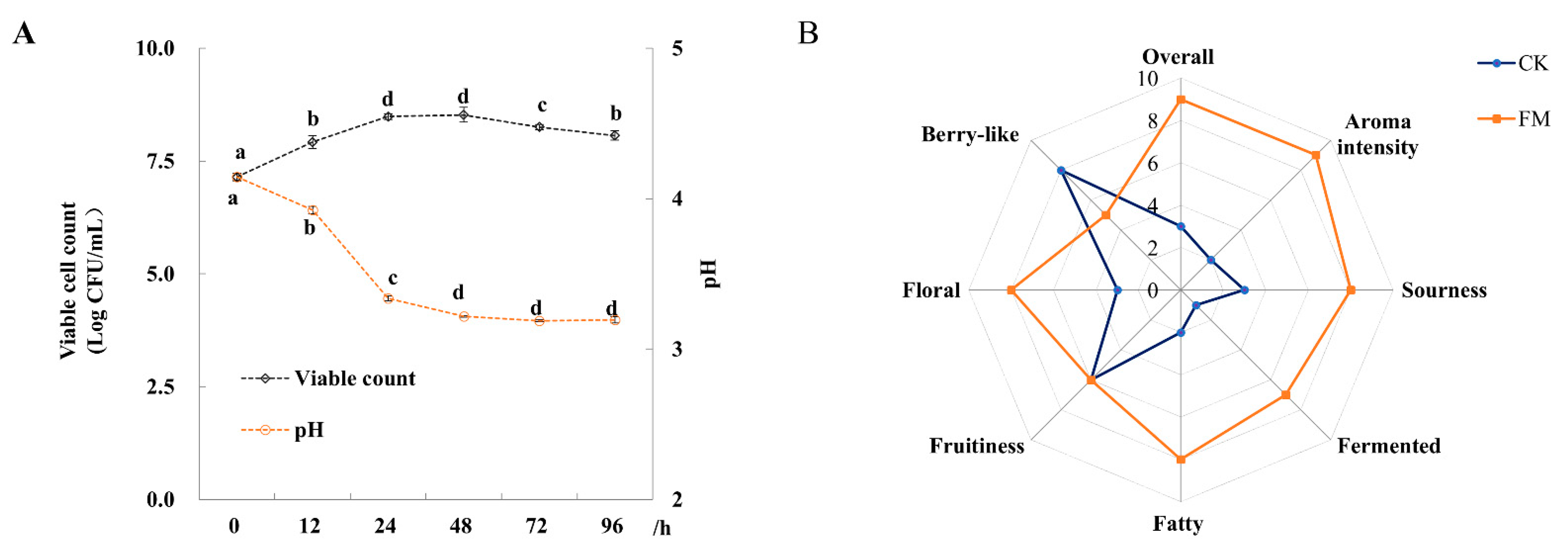
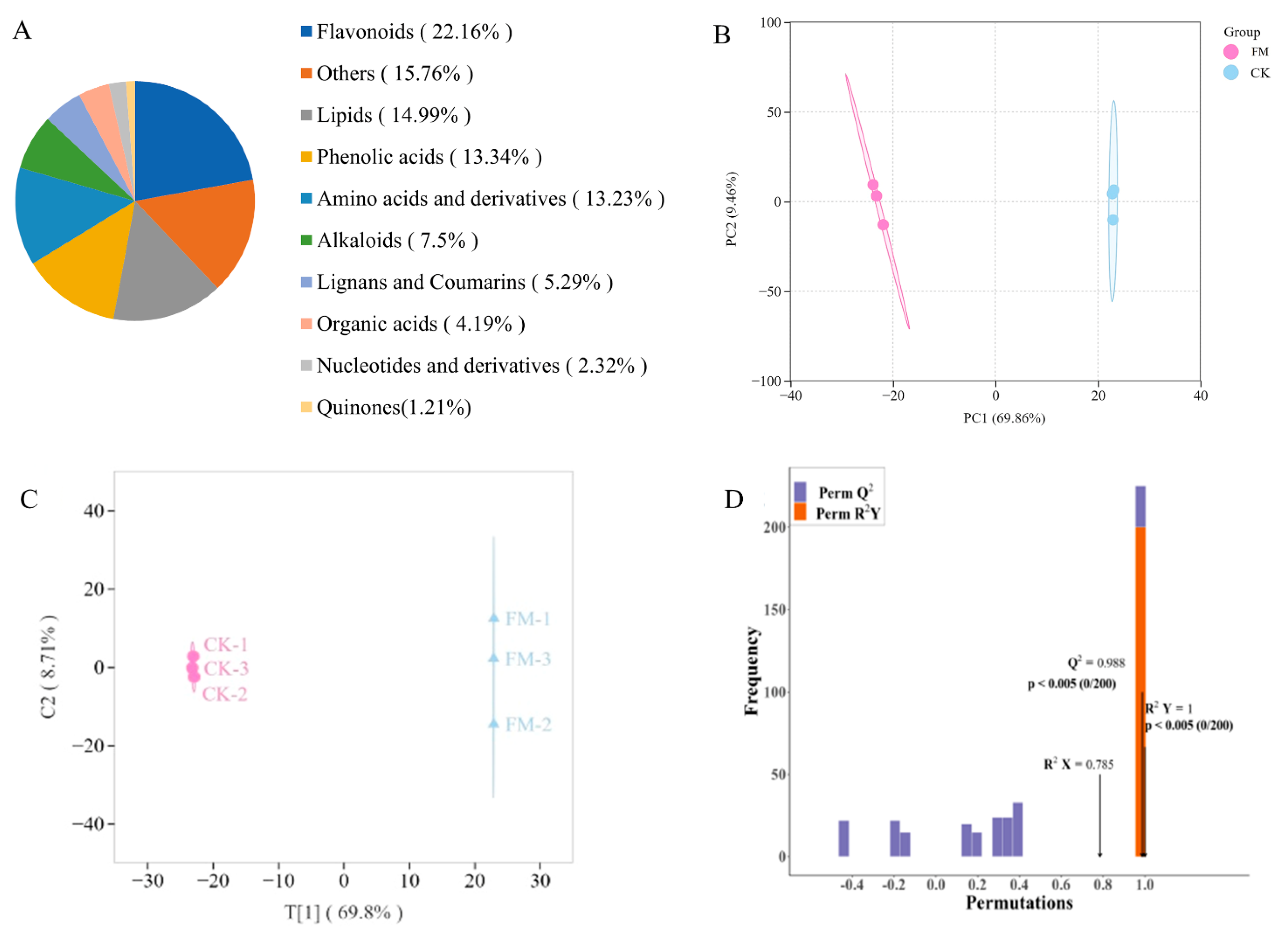

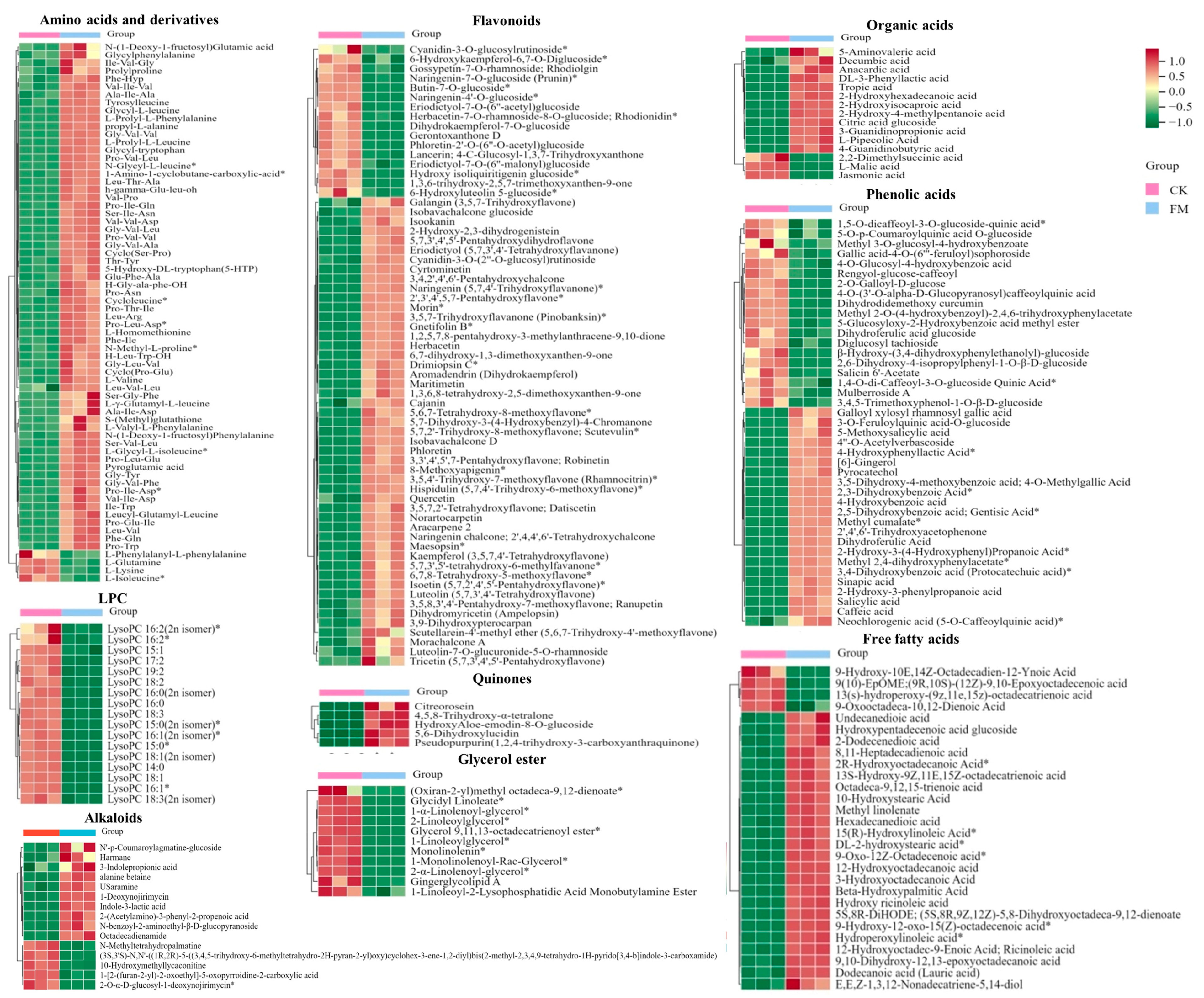
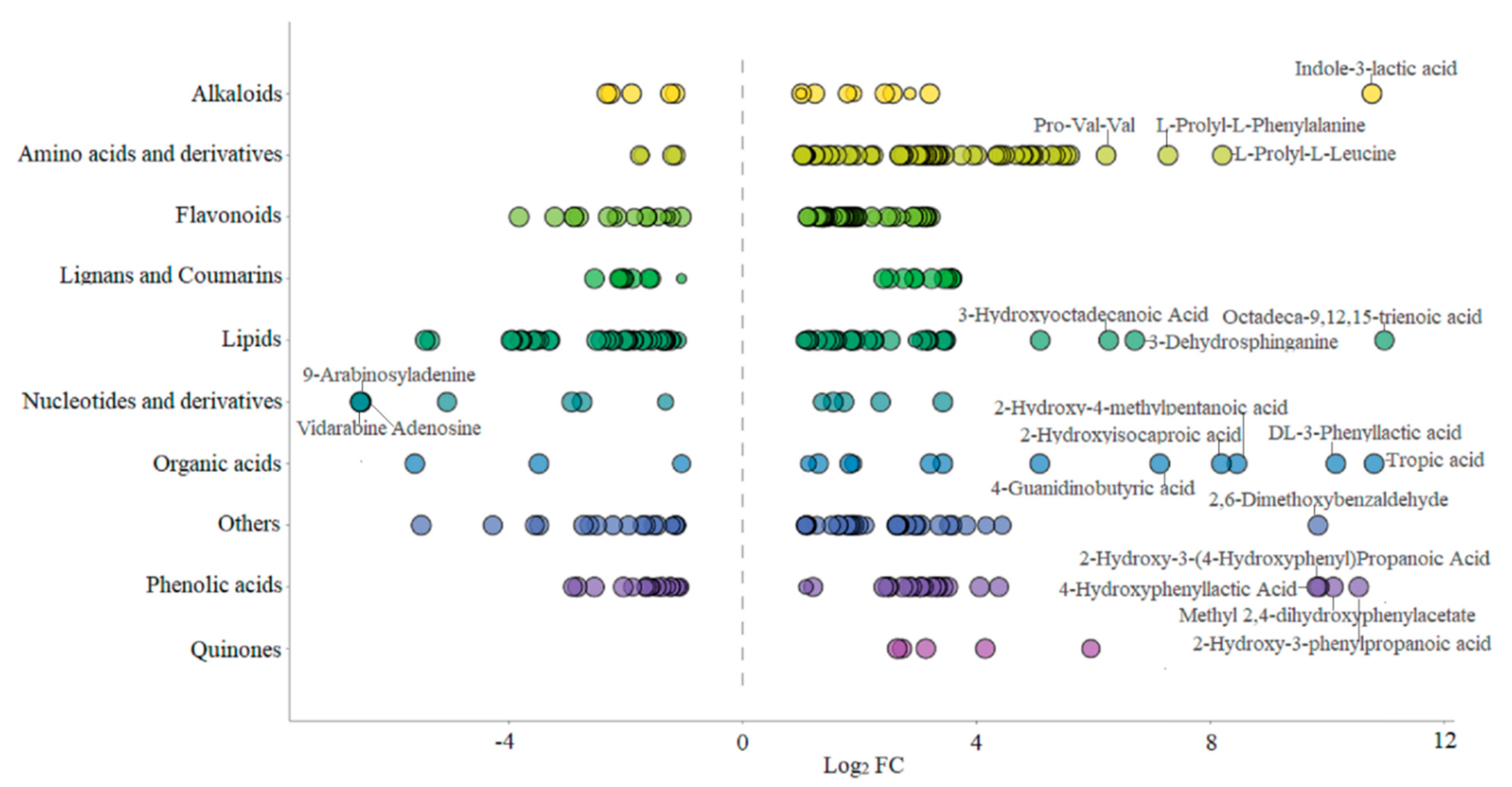
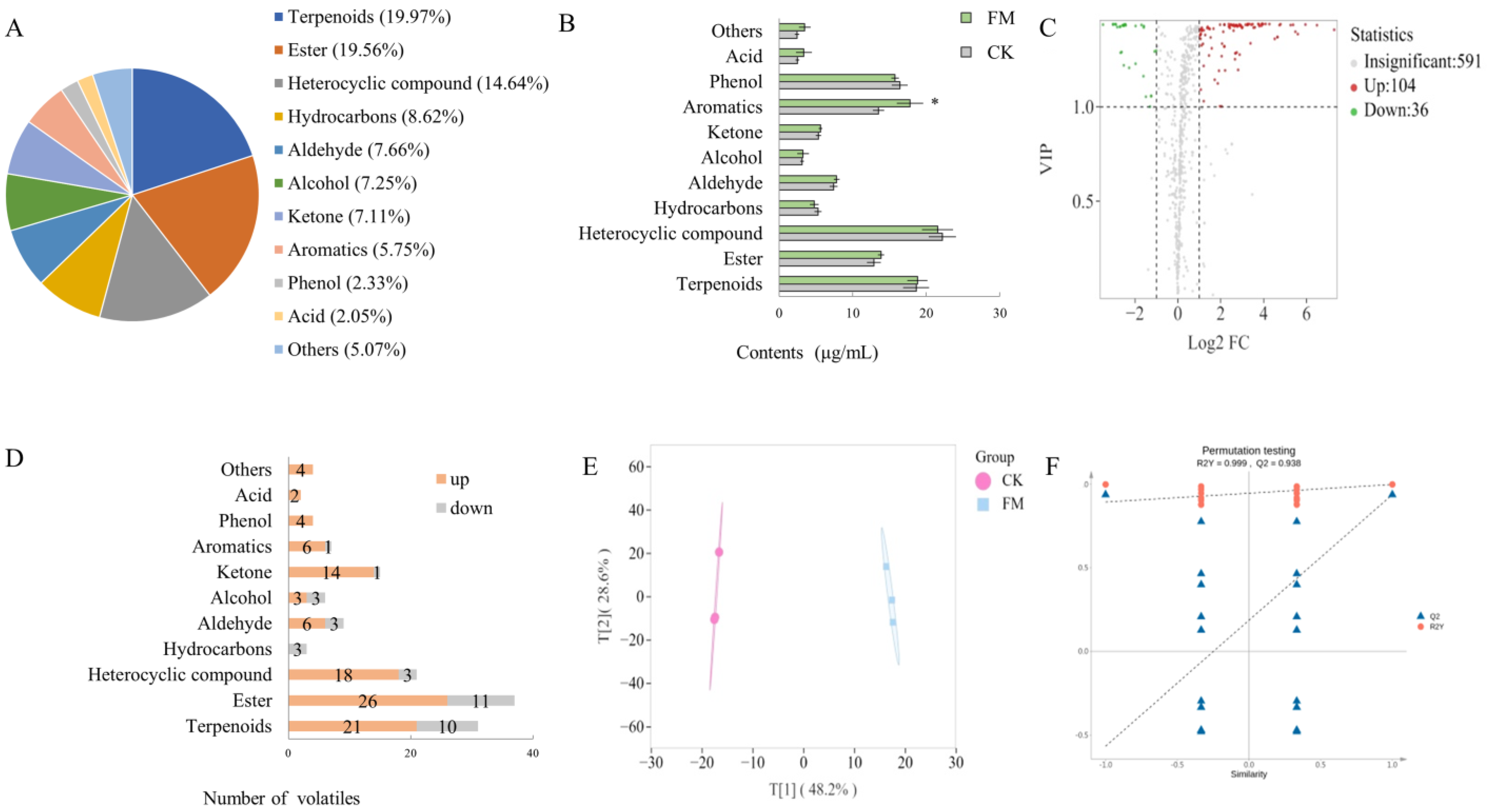
| Compounds | Concentration (μg/L) | ROAV | Type | Fold Change | ||
|---|---|---|---|---|---|---|
| CK | FM | CK | FM | |||
| Ester | ||||||
| Butanoic acid, 2-methylpropyl ester | 1.05 ± 0.03 | 5.78 ± 0.79 | 0.11 | 0.62 | up | 6.12 |
| Butanoic acid, butyl ester | 1.73 ± 0.07 | 23.45 ± 8.70 | 0.06 | 0.84 | up | 14.93 |
| Decanoic acid, methyl ester | 31.19 ± 10.17 | 81.39 ± 11.28 | 7.25 | 18.93 | up | 2.89 |
| Dodecanoic acid, methyl ester | 1.72 ± 0.07 | 29.75 ± 0.77 | 0.49 | 8.50 | up | 19.31 |
| Methyl salicylate | 9.50 ± 0.86 | 235.66 ± 14.30 | 0.24 | 5.89 | up | 27.61 |
| 3-Hexen-1-ol, acetate, (Z)- | 61.48 ± 8.18 | 9.51 ± 0.53 | 1.98 | 0.31 | down | 0.17 |
| Butanoic acid, ethyl ester | 17.53 ± 4.53 | 6.26 ± 4.22 | 330.70 | 118.12 | down | 0.41 |
| Hexanoic acid, ethyl ester | 6.41 ± 0.61 | 1.44 ± 1.39 | 1.28 | 0.29 | down | 0.25 |
| Aromatics | ||||||
| 2-Methoxy-4-vinylphenol | 15.65 ± 10.31 | 348.30 ± 33.37 | 5.22 | 116.10 | up | 25.04 |
| Benzene, 1-ethyl-2-methyl- | 234.06 ± 25.46 | 1560.69 ± 226.54 | 0.65 | 4.34 | up | 7.39 |
| Naphthalene, 1,2-dihydro-1,1,6-trimethyl- | 2.94 ± 0.30 | 23.59 ± 0.53 | 1.18 | 9.43 | up | 8.92 |
| Phenol | ||||||
| Eugenol | 5.78 ± 3.71 | 118.61 ± 2.68 | 2.31 | 47.44 | up | 22.91 |
| Phenol, 4-ethyl-2-methoxy- | 1.15 ± 0.08 | 4.06 ± 0.28 | 0.03 | 0.12 | up | 3.91 |
| Ketone | ||||||
| 1-(4-methylphenyl)-Ethanone | 2.97 ± 0.41 | 5.52 ± 0.19 | 0.14 | 0.26 | up | 2.06 |
| 1-Octen-3-one | 9.68 ± 6.38 | 40.11 ± 6.21 | 193.61 | 802.14 | up | 4.60 |
| 2-Undecanone | 1.09 ± 0.04 | 9.23 ± 1.08 | 0.18 | 1.49 | up | 9.45 |
| Acid | ||||||
| Nonanoic Acid | 9.21 ± 5.97 | 61.08 ± 8.41 | 5.76 | 38.17 | up | 7.37 |
| Aldehyde | ||||||
| BenzAldehyde | 153.46 ± 11.51 | 1055.10 ± 147.30 | 0.44 | 3.01 | up | 7.62 |
| Octanal | 1.23 ± 0.05 | 5.75 ± 0.48 | 1.76 | 8.22 | up | 5.19 |
| 3-Hexenal, (Z)-; (Z)- | 127.89 ± 1.41 | 14.22 ± 0.79 | 31.97 | 3.56 | down | 0.12 |
| Alcohol | ||||||
| 3-Mercapto-3-methylbutanol | 3.65 ± 0.27 | 6.98 ± 1.12 | 0.91 | 1.74 | up | 2.12 |
| 4-Phenyl-2-butanol | 0.81 ± 0.03 | 5.58 ± 0.98 | 0.19 | 1.30 | up | 7.73 |
| Terpenoids | ||||||
| 4-(1-methylethyl)-Benzaldehyde | 6.90 ± 0.75 | 42.69 ± 6.17 | 0.02 | 0.11 | up | 6.87 |
| Heterocyclic compound | ||||||
| 3,6-Dimethyl-2,3,3a,4,5,7a-hexahydrobenzofuran | 3.73 ± 0.21 | 9.39 ± 0.96 | 0.12 | 0.31 | up | 2.81 |
| 2-Furanmethanethiol, 5-methyl- | 11.99 ± 2.95 | 1.72 ± 1.66 | 239.84 | 34.41 | down | 0.16 |
| Furan, 2-pentyl- | 107.19 ± 28.53 | 45.28 ± 5.54 | 17.87 | 7.55 | down | 0.47 |
Disclaimer/Publisher’s Note: The statements, opinions and data contained in all publications are solely those of the individual author(s) and contributor(s) and not of MDPI and/or the editor(s). MDPI and/or the editor(s) disclaim responsibility for any injury to people or property resulting from any ideas, methods, instructions or products referred to in the content. |
© 2024 by the authors. Licensee MDPI, Basel, Switzerland. This article is an open access article distributed under the terms and conditions of the Creative Commons Attribution (CC BY) license (https://creativecommons.org/licenses/by/4.0/).
Share and Cite
Guan, X.; Zhao, D.; Yu, T.; Liu, S.; Chen, S.; Huang, J.; Lai, G.; Lin, B.; Huang, J.; Lai, C.; et al. Phytochemical and Flavor Characteristics of Mulberry Juice Fermented with Lactiplantibacillus plantarum BXM2. Foods 2024, 13, 2648. https://doi.org/10.3390/foods13172648
Guan X, Zhao D, Yu T, Liu S, Chen S, Huang J, Lai G, Lin B, Huang J, Lai C, et al. Phytochemical and Flavor Characteristics of Mulberry Juice Fermented with Lactiplantibacillus plantarum BXM2. Foods. 2024; 13(17):2648. https://doi.org/10.3390/foods13172648
Chicago/Turabian StyleGuan, Xuefang, Dazhou Zhao, Tian Yu, Shaoquan Liu, Shuying Chen, Junyang Huang, Gongti Lai, Bin Lin, Juqing Huang, Chengchun Lai, and et al. 2024. "Phytochemical and Flavor Characteristics of Mulberry Juice Fermented with Lactiplantibacillus plantarum BXM2" Foods 13, no. 17: 2648. https://doi.org/10.3390/foods13172648





